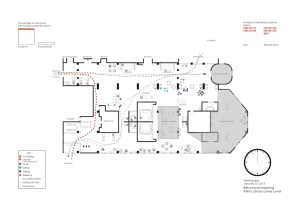VALSE- Computer vision tool for large scale occupant evaluation.

Recent advances in computer vision are bringing automated analysis of human motion within reach. We have developed the SENSING Toolkit, a framework for collecting and storing long-term, large-scale human motion. Our framework is designed to use a computer vision system, including a network of cameras installed in large indoor spaces, such as building lobbies or healthcare facilities. The system uses ray-tracing logic to detect and track persons and collect metrically accurate locations of where people have been over time and identify activities that were undertaken while they occupied a location. All of this data is collected while protecting the anonymity of the user, by never recording their actual image.
Data collection is just the start, however. To facilitate analysis over very long timeframes, we have developed an interactive, visual analysis interface called VALSE (Visual Analytics for Large-Scale Ethnography), designed to allow domain experts to query and understand the data. VALSE follows a many-coordinated-views paradigm to present a user with motion summaries such as heat maps, scatter plots, and motion trails, as well as avatar-based, animated reconstructions of activity. These visualizations can be dynamically customized with user-defined time intervals for targeted analysis and replayed using a familiar DVR-style interface. This type of tool can expand the reach of traditional social science analysis. VALSE leverages the ability of human ethnographers to recognize meaningful patterns of behavior with the computational ability to apply these insights for very extended periods of time.
Because this work is particularly well suited to scenarios such as health care, which have a large number of actors and a complex set of actions and intentions, we have begun with the study of various programmatic components of clinic and hospital floor plates. As part of a collaboration with a national architectural design firm, this project creates a tangible analysis of the organizational systems
implemented in these complex and highly orchestrated design problems. Rather than rely on a short-term analysis by an ethnographer or partial semantic data from occupants which is often multiplied out to create averages, VALSE creates a comprehensive analysis of the actual use and performance of each floor or clinic, with real analytics over much longer time periods. There are two specific outcomes of this research. First, it allows for a fine-grained understanding of the uses that are made of facilities, which could, in turn, lead to improved future design. And second, the analysis of the human use of the architectural setting can potentially become a part of the therapeutic setting, allowing adjustments to individual patient’s therapy.